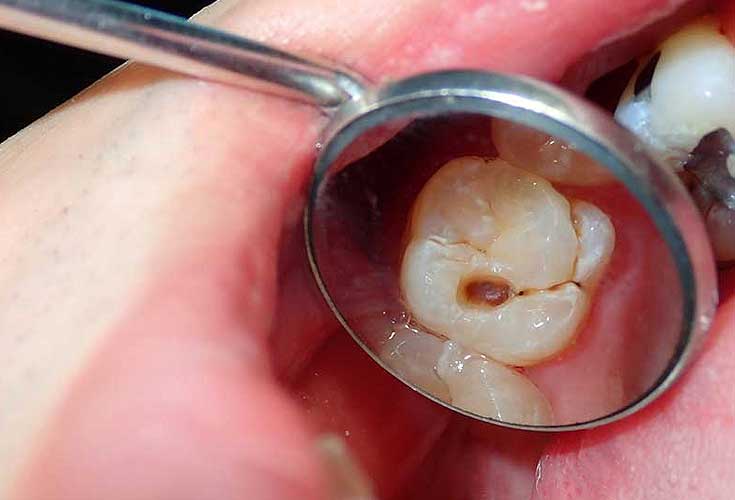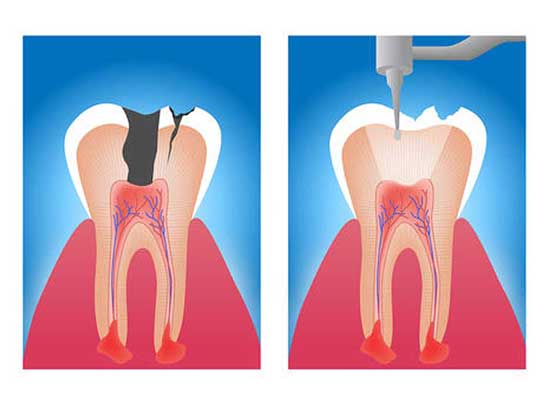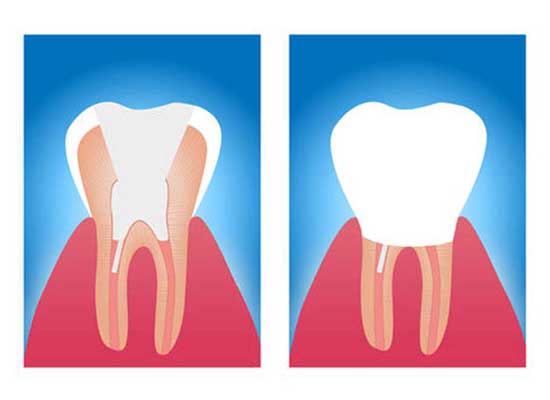Root Canal Treatment
Endodontics
Root canal treatment eliminates bacteria from the infected root canal, prevent reinfection of the tooth and save the natural tooth. When one undergoes a root canal, the inflamed or infected pulp is removed and the inside of the tooth is carefully cleaned and disinfected, then filled and sealed.

What are the 3 stages of root canal treatment?
If your dentist has informed you that you require root canal therapy to treat an infected or broken tooth, you may be wondering what exactly a root canal entails – or even what a root canal looks like.
When planning for root canal treatment, keep in mind that you may need to visit the dentist more than once. While this may appear to be a lengthy procedure, root canal therapy is one of the most effective treatments to save a dying tooth and relieve nerve pain in your tooth, so it is well worth the extra visit!In this post, we’ll go over the three steps of root canal therapy so you’re ready when it comes time for your root canal surgery.



What can I expect from root canal treatment?
If you have pain, increased sensitivity, swollen gums, or other signs of tooth decay, you may have a bacterial infection inside your tooth. Your dentist may offer root canal treatment to remove this infection.
The goal of a root canal is to remove the infection and limit the risk of future infections. Root canal therapy can salvage an infected or seriously damaged tooth, allowing your dentist to address the problem and relieve your symptoms without having to extract the tooth (a much more involved and expensive surgery).
While we understand that frequent visits to your local dental office aren’t ideal, they are required to complete the three stages of root canal treatment and guarantee your tooth is entirely free of infection.
Here are the three stages of your root canal treatment:
Stage 1 of root canal treatment: evaluation and first cleaning
This first stage will include an examination of your tooth to determine whether a root canal is necessary, followed by an initial clean to reduce the bacterial infection in the tooth.
After numbing your tooth, your dentist will make a small opening on the top of the tooth to clean the root canal properly. Rinsing with antibacterial liquids and administering medication are examples of this.
Before proceeding to stage two of your root canal treatment, a temporary filling will be placed in the tooth.
Stage 2 of root canal therapy includes a follow-up clean and medication.
The second stage of your root canal treatment may be conducted on the same day as the first, although it may be performed 1-2 weeks later.
This stage is a more thorough cleaning of the root canal to eradicate any leftover bacteria within the tooth. In order to guarantee that the entire canal is cleaned, your dentist may also take x-rays.
To treat the infection, your dentist will also apply medicine to the tooth.
Stage 3 of Root Canal Treatment: Filling the Root Canal
Once the root canal is entirely free of bacteria and your symptoms have subsided, the root canal can be filled. This usually occurs 4-6 weeks after the second step of your root canal treatment.
Filling the root canals entails inserting specific rubber points into the channels prior to sealing the canal. Depending on the degree of your tooth injury and situation, a temporary or permanent filling may be implanted.
Is a root canal painful?
Although many individuals are apprehensive about the prospect of root canal therapy, the reality is that it is rarely more painful than receiving a filling or undergoing another dental procedure. Additionally, as an anaesthetic will be administered prior to the procedure to neutralise your tooth, you will not experience any discomfort throughout the process.
Each of our dentists possesses extensive knowledge and expertise in root canal procedures and will make every effort to ensure your complete comfort and relaxation.
It is crucial to bear in mind that a root canal is an essential and extraordinarily efficacious treatment for mitigating the discomfort and pain associated with a tooth that is decayed or infected. Toothache, inflammation, and sensitivity are forms of such symptoms. While the thought of a root canal may evoke apprehension, it is your most reliable option for eliminating those undesirable symptoms.
Uncertain of the signs that indicate the need for root canal therapy? Check out How To Know When You Need a Root Canal.
What happens if the infection is not treated?
If a root canal is not performed when necessary, this can result in significantly more severe health consequences. The bacterial infection in your tooth is not self-healing; therefore, it can travel to the brain, blood, jaw, and other areas of your body if left untreated.
Untreated dental infections not only prolong the pain and discomfort associated with infected teeth (such as excruciating toothache, sensitivity, swelling, and pus), but also have the potential to lead to tooth loss.
Having the tooth extracted is the sole alternative to root canal therapy. This is an exceedingly intricate and expensive process that is preferably prevented unless it is an absolute necessity.
Discuss what’s right for you
If your dentist has advised you that you require root canal treatment or you suspect that you may be experiencing symptoms that indicate the need for one, it is critical that you do not delay treatment. A root canal may be among the most effective treatments for a contaminated tooth, relieving the patient of the excruciating symptoms that have been present.
Contact us ((03) 9878 3233) immediately to learn more about root canal treatment, including its potential costs and the steps involved.
All You Need To Keep Smiling
Payment Options / Plans
Payment plans are essentially loans, which can support you in managing the high cost of dental treatment. Rather than paying for your dental work in an upfront lumpsum, a payment plan allows you to pay in instalments over a period of time. We have onboard, payment plan service providers who will make your payment plan’s instalments even more affordable.
There are several payment options available at our surgery including Cash, Cheque, EFTPOS, Credit Card, HICAPS, AMEX and Direct Deposit.


